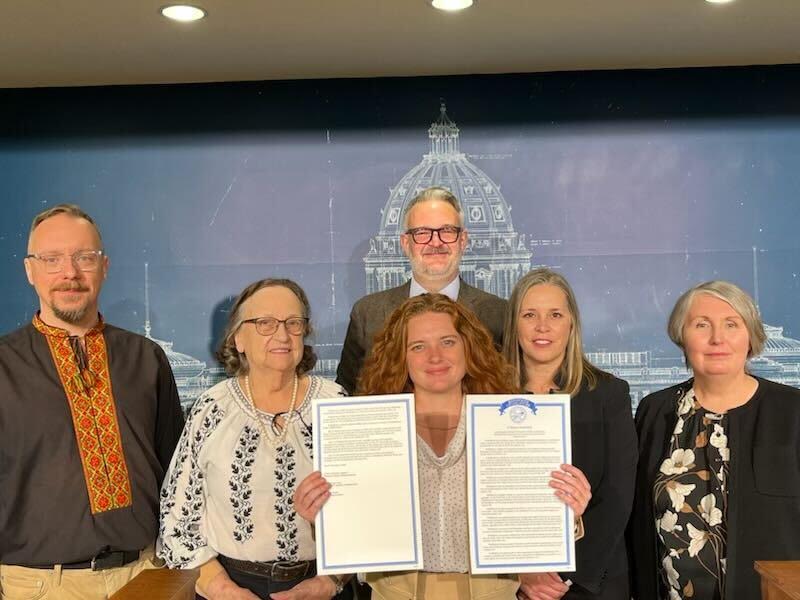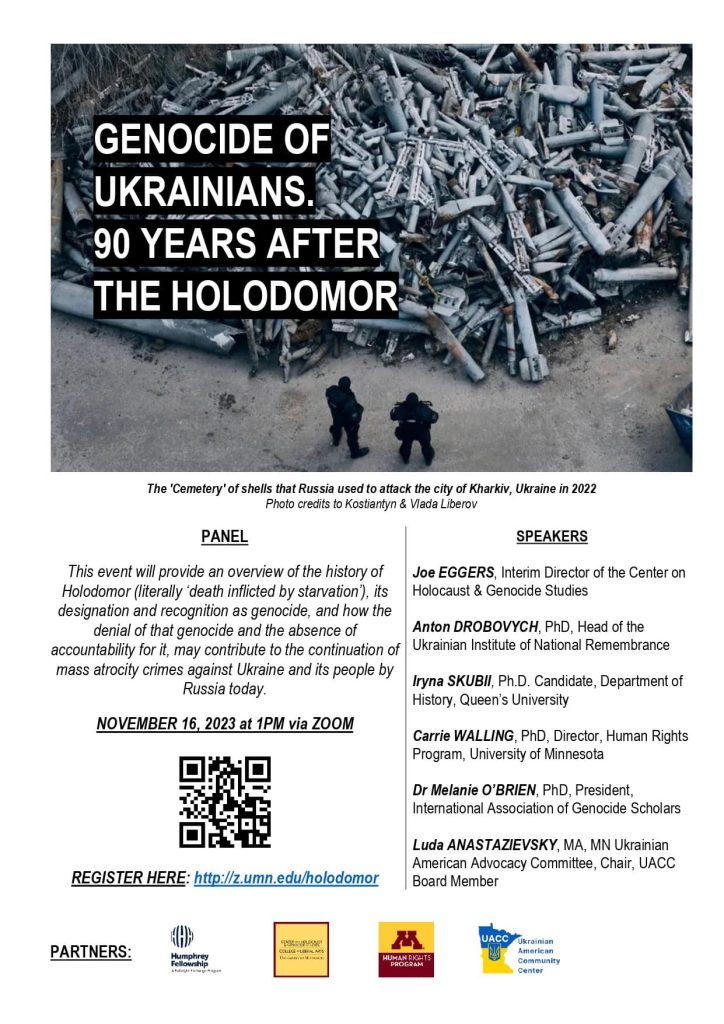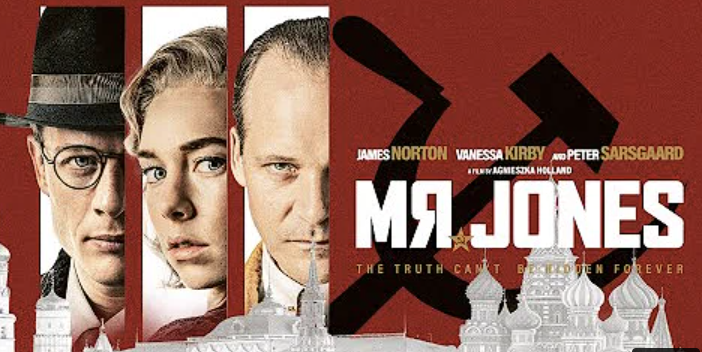HOLODOMOR ’90
2022-2023 marks 90th anniversary of the Holodomor. Minnesota Ukrainians held several commemorative events.
In November of 2022, Governor Walz issued a Proclamation in honor of the 90th anniversary of the Holodomor proclaiming November 24-December 1, 2022 to be Ukrainian Famine-Genocide Remembrance Week. It said, “In commemorating the 90th anniversary at the start date of Ukraine’s Famine-Genocide of 1932-33, Minnesota joins with the Ukrainian American community in Minnesota and throughout this nation to honor the memory of the millions of victims of the Holodomor, to those who perished, as well as those who survived enduring prosecution, starvation, and death of loved ones, yet whose faith and resiliency sustained them and their children in perilous times and guided them to a new life of freedom here in the United States.”

At the commemoration of the 90th anniversary of the Holodomor on November 8th, 2023, at the St. Paul. Capitol Rotunda, Minnesota Ukrainian community was honored to welcome the First Lady, Gwen Walz, who presented a letter from Governor Tim Walz. She said, “Minnesota is proud to be home to so many Ukrainian families…As we remember the past today, we safeguard the future. We shine a light on one of the darkest corners of history.”
Senator Amy Klobuchar and Congresswoman Betty McCollum provided letters of support in honor of the 90th anniversary of the Holodomor.
On November 8th, 2023, State Representative Sydney Jordan, the House Majority Assistant Leader, introduced a House Resolution commemorating the 90th anniversary of the Holodomor. The Resolution established the last week of November as Holodomor Memorial Week and November 25th, 2023 as Holodomor Memorial Day in Minnesota this year and thereafter.
She said, ” I want to thank the community advocates that are here today from the Minnesota Ukrainian American Advocacy Committee, as well as the Center for Holocaust and Genocide Studies and the University of Minnesota Human Rights Center. It is vital we continue educating the next generation and each other, especially as war rages on and decimates Ukraine today. The Minnesota House stands with the people of Ukraine.”
Read more about the November 8 Holodomor commemoration in the UACC Facebook post below.

The artwork “Because We Are Ukrainians” created with mixed media by Luda Anastazievsky with the Voice to Vision project collaborators was showcased at the commemoration.
It’s a reflection on the “personal and collective trauma of two genocides that my family and Ukrainian society have experienced. It’s the trauma of ninety years ago during the Holodomor, and now, with the full-scale Russian invasion that had started February 2022, explained Luda.
It’s been added to the U of M’s Conservatory Library with an art description about its meaning and purpose.

On November 16th a panel “Genocide of Ukrainians. 90 years after the Holodomor” hosted by the Global Policy Area of Humphrey School of Public Affairs at the University of Minnesota took place.
Speakers
– Joe Eggers, Interim Director of the Center on Holocaust & Genocide Studies
– Anton Drobovych, PhD, Head of the Ukrainian Institute of National Remembrance
– Carrie Walling, PhD, Director, Human Rights Program, University of Minnesota
– Luda Anastazievsky, MA, MN Ukrainian American Advocacy Committe, Chair, UACC Board Member
This is an event organized by Iryna Drobovych, a 2023-2024 Humphrey Fellow at the Humphrey School of Public Affairs at the University of Minnesota in collaboration with the Center for Genocide and Holocaust Studies, the Human Rights Program, the MN Ukrainian American Advocacy Committee, and Ukrainian Center.

What was the Holodomor, and what does the word “Holodomor” mean?
A few years after Ukraine was forcibly incorporated into the Soviet Union, the Communist regime of Soviet dictator Joseph Stalin embarked on a campaign to break the resistance of the Ukrainian people, especially its fiercely independent farmers. Its plan: engineer and brutally enforce a man-made famine, and starve Ukrainians into submission. The result: in the land called the breadbasket of Europe, millions of men, women and children starved to death. This horrendous act of genocide against the Ukrainian people is known as the Holodomor –murder by starvation.
Other modern genocides in Ukraine
“Holocaust by bullets” in Ukraine
(1941-1945)
Forced deportation of Crimean Tatars, indigenous people of the Crimean peninsula in 1944

This 2019 biographical thriller was directed by Agnieszka Holland and selected to compete for the Golden Bear awards at the 69th Berlin International Film Festival. It can be streamed on Netflix, Hulu or Amazon Prime. “How ‘The New York Times’ Helped Hide Stalin’s Mass Murders in Ukraine.”
Holodomor Resource Guide
Read more about the UACC’s efforts to educate the public about the Holodomor, “Minneapolis Ukrainian center educates teachers, public about Holodomor.”
Ukrainian American Community Center collaborated with the Center for Holocaust and Genocide Studies at the University of Minnesota and the Holodomor Research and Education Consortium (HREC) at the Canadian Institute of Ukrainian Studies, University of Alberta to create a Holodomor Resource Guide for the Genocide Education Outreach Program.
Oral history project: Holodomor Impact on Minnesota’s Ukrainian Community
Professionally recorded video files and written, annotated transcripts of 11 interviews with Holodomor survivors, and children and grandchildren of survivors are permanently housed at the Immigration History Research Center Archives, located at the University’s Elmer L. Andersen Library. The project was supported by a grant from the Minnesota Historical Society and administered through the Ukrainian American Community Center in Minneapolis. Read more here.
Holodomor Commemoration – fourth Saturday in November
On this day, Ukrainians all over the world light candles to commemorate the victims of Holodomor.
“During the Holodomor, 17 people were dying every minute, 1000 every hour, almost 2500 every day.”
Holodomor National Museum, Kyiv, Ukraine
Holodomor Resources:
- U.S. Holodomor Committee: Holodomor Resources
- CHGS & UACC : Bridges of Memory Community Dialogue: The Holodomor
- CHGS, HREC, UACC: In Commemoration of International Holodomor Memorial Day: Teaching a Genocide the World Forgot